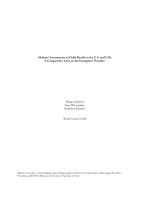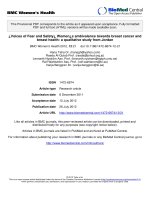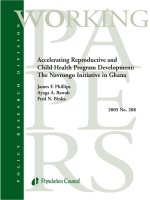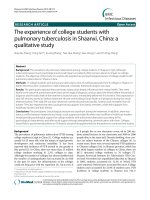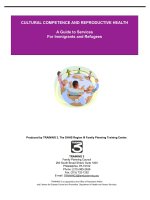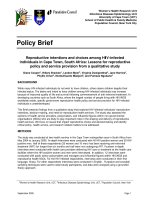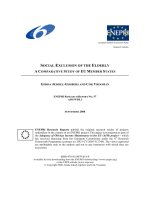Coping with ageing and failing health: A qualitative study among elderly living alone doc
Bạn đang xem bản rút gọn của tài liệu. Xem và tải ngay bản đầy đủ của tài liệu tại đây (115.09 KB, 13 trang )
1
Coping with ageing and failing health: A qualitative study among elderly
living alone
Arvid Birkeland, førstelektor Høgskolen Stord/Haugesund
Gerd Karin Natvig, førsteamanuensis Høgskolen Stord/Haugesund
Publisert i International Journal of Nursing Practice 2009; 15: 257-264
Abstract
The purpose of this study was to gain a more comprehensive understanding of how elderly cope with being sick,
unhealthy and living alone. Qualitative research interviews using a hermeneutic approach was undertaken to
explore how the patients experienced coping with their daily life. Twenty patients with an average age of 82
years having different injuries and diseases were interviewed. The interviews were audiotaped, transcribed and
analysed in a hermeneutical tradition of the hermeneutic circle: part – whole, preunderstanding – understanding
and primary, secondary and basic themes. Findings showed that even if physical constraints put limits on their
level of activity, the elderly were able to adapt and carry out different activities that did not require any physical
strength. The main coping strategy was to accept the situation, but the acceptance was often colored by a
resigned and passive acceptance. If elderly tend to be passive and resigned, it can be necessary for the
community nurses to have a more active problem-solving approach to these patients, in order to help them
creating a daily rhythm with which they can feel comfortable.
Keywords: Elderly, coping, disabled, home nursing care.
Introduction:
The number of aging people in Norway has increased gradually forward to 1990. From 2010
there will be a new increase from 600000 to approximately 1, 1 million in 2045 (1). Europe
has approximately the same proportional increase, even if some countries have a greater
increase than others (2). Many of these elderly people live alone with different types of
dysfunctions and some receive help from home nursing care. Some studies show that it’s
important for elderly people to live in their own home, as it helps to connect the elderly to a
meaningful past, and maintains their privacy and independence (3). At the same time, one can
imagine that it must be difficult for the elderly to handle their daily life when they live alone
with different medical problems. There is a lack of earlier studies about how elderly cope with
being unhealthy in addition to living alone in their own home. There are, however, many
studies about how the elderly experience their social situation (4, 5, 6, 7). These studies show
that around five to ten percent seem to have difficulties with contact with others over time,
and between ten to forty percent seem to have periodic problems with maintaining to social
contact. An interesting thing is that there are two essential factors to these problems. The first
is health failure, and the other is bereavement related to loss of a spouse or near friends (7, 8,
9, 10, 11, 12). Consequently this indicates that coping with health failure and dysfunctions
combined with living alone, can be difficult for the elderly.
2
Several studies show that elderly accept and are satisfied with living alone in their own home
even if they are more or less unhealthy, but at the same time they fear being dependent of help
from others (13, 14, 15, 16, 17). Some other studies show that patients with chronic pain, who
reflect low self-esteem, seem to engage more in emotion-focused coping, while people with
high self-esteem rely more on problem-focused coping, are less depressed, and show a more
positive adjustment (18). The key coping features of depressed elderly patients with a chronic
illness are their general use of emotion-focused coping strategies, such as passivity and
holding oneself back (15).
Coping is a term that is widely used in nursing, and the concept quickly leads to the notion of
stress, because they relate symmetrically to each other. Coping involves references to
psychological states, but helping and supporting people in coping are in any case an integral
component of nursing care (19, 20). Coping can be defined as:
Constantly changing cognitive and behavioural efforts to manage specific external or
internal demands that are appraised as exceeding the resources of the person (21).
All coping begins with an appraisal, and the purpose of the appraisal is to assess the
controllability of the external stressor.
Coping is both a personality trait and a process changing over time according to the situation
that occurs (22, 23, 24). The coping process emphasizes two major functions of coping;
problem and emotion-focused coping. Problem-focused coping means to change the
environment or oneself. Emotion-focused coping means to change the meaning or change the
way the stressful relationship with the environment is attended (23, 24, 25). The two functions
are normally combined and they support each other in most stressful encounters. If nothing
useful can be done to change the situation, emotion-focused coping seems to be the best
coping choice. If the situation is appraised as controllable by actions, problem-focused coping
predominates (22). There may be no universally good or bad coping processes, though some
might often be better or worse than others. The term coping is also used whether the process
is adaptive or non-adaptive, or successful, or unsuccessful (24, 26). All types of reactions are
a type of coping, and individuals meet the encounter with their personality characteristics,
appraisals of threats and harm and benefits (20, 22). The way individuals cope changes over
time and depends on the context in which the encounter occurs and how the coping process is
integrated (26, 27).
3
The present study is one of three studies based on the same qualitative data. One study
focused on the patient’s experience of their social situation, and one planned study has
focuses on how the community nurses and the community health service are able to take care
of the patients social needs. The present study focused on both how the patients cope with
being sick and disabled over time, and how they cope with changes in their physical health. It
means that sickness and disabilities can exceed their capability to manage the situation,
especially when they live alone, and the question is what cognitive and behavioural efforts
they work out to manage different demands they meet as a consequence of their sickness and
disability. The study had therefore following research question:
How do elderly with sickness and extensive dysfunctions and receiving help from the
home nursing care service, cope with being alone in their own homes?
Method
Qualitative research using taped qualitative research interviews were undertaken to explore
how the elderly experienced coping with being sick and alone in their own residences. The
analysis was carried out using a hermeneutic approach with preunderstanding, interpretation
and understanding as central elements (28). Preunderstanding is the knowledge before
meeting with the respondents. In a hermeneutic approach, preunderstanding is seen as
important and helpful, but one must be aware of that the preunderstanding can overshadow an
extended understanding. Qualitative semi structured research interviews were used as method
(29). The practical implementation of the interviews was based on an open approach with
open questions based on the study’s research question, and consisted of topics on the patient’s
thoughts on; coping with their situation, how they spend their time during a day/week, and
contact with others. In the interview, each topic was followed up with spontaneous subsequent
questions.
Data collection
The interviews were carried out in two municipalities scattered in three randomly selected
home nursing care districts over a twelve-month period from April 2005 to April 2006.
Information about the project was communicated both through conversations and written
materials; first to the home nursing care service, and afterwards to the patients. The
information to the respondents was carried out of community nurses familiar with the
patients. Patients, who fulfilled the criteria, were contacted by telephone in order to make an
appointment for a visit. The interviews were carried out alone with each patient, it means
4
researcher and respondent, in their own home and had a duration of 1 – 1. 5 hours. This
resulted in a long and probing conversation with each patient.
Sample
The selection of the respondents was based on the following criteria:
• Older adults > 70 years of age, living alone in their own home with help from the
home- care service, for at least two months.
• Older adults able to complete a normal conversation and tell about their experiences.
• Older adults appraised by the home nurses to be in a psychosocial difficult situation,
either as a main problem or as a problem in addition to other circumstances
Participants
Twenty individuals (12 women and 8 men) participated in the study. They had an average age
of 82.5 years with a range from 72 to 93 years. Seven were between 70 and 80, nine between
80 and 90, and four were > 90 years old. Ten respondents went to a day care centre once or
more during a week. Six respondents lived in specially prepared buildings, and three of these
went to a day care centre. The respondents had different physical health problems. The most
serious problems were divided among respondents as follows: Five had osteoarthritis of the
hip and/or complications after hip surgery while two had arthritis. Stroke was the main
problem for six respondents. Four respondents had problems with breathing due to chronic
obstructive pulmonary disease and/or serious heart failure. One respondent had a combination
of stroke and chronic obstructive pulmonary disease, and one respondent had a combination
of stroke and serious heart failure. One respondent had a serious brain injury after a brain
disease and following brain surgery.
Data analysis
The analysis consisted of several stages and several readings in each stage, according to the
circular process in the hermeneutical circle (28). The first stage was analysis and
interpretation in the interview situation (29). The next stage was transcribing combined with
an initial analysis of content in the interviews. The third stage was a reading of all the
interviews in order to identify general themes, and then a new reading of all interviews in
order to identify primary- themes. In the next review identify secondary- themes for each
primary- theme and at the end a new review in order to identify basic- themes or elements
5
which could support the secondary- themes. The last stage existed of interpretation and
discussion against theory and earlier research relevant for the research question.
Ethical considerations
The Norwegian Ethical Committee for Medical Research and Norwegian Social Science Data
Services had to approve the project, and they demanded that the elderly had to give their
informed consent to participate in the study and that recruitment of the participants was
selected by the community nurses. Thus the selection of participants was done by people
familiar with the patients.
Result
Primary, secondary and basic themes of experienced coping with sickness and extensive
dysfunctions emerged through the conversations with twenty older patients and the following
transcribing and text analysis (see table below).
Table1. Distribution of themes
Primary themes Secondary themes Basic themes
♦ Acceptance
■ resigned and passive
■ positive
● nothing else to do ● have to live the way
one can now ● feel tired and weak ● see that
life has changed ● deal with things as they
appear ● submit to ● hope the best ● that’s
the way life is ● don’t dwell on an uncertain
future ● don’t give up
♦ Perform activities
they are able to carry
out
■ use what one have
■ cultivate interests
■ good to have something to do
■ do what one can do
● read newspapers ● read weekly papers ●
look at movies● solve crosswords ● look at
news
● read periodicals ● read books● knit
● music ● needlework ● radio ● bet on
football and horses
● make food ● clean up
● telephone
♦ Create a new rhythm
■ find a way to live
■ get accustomed to
■ something to look foreword to
■ have a diurnal plan
■ make/have a weekly plan
● make oneself comfortable ● have to enjoy
oneself
● make arrangements ● TV at stated
times
● prepare meals and eat at stated times
● rest at stated times ● out of bed at stated
times
● day center at stated times ● home
nursing care at appointed time
● hobby –
activities at stated times
Acceptance
A general coping strategy is to accept the situation as it appears. The elderly convey the
impression of being in a situation of “having their backs up against the wall” because they
feel age and sickness can catch up with them at any time. Their life situation has changed, and
time cannot be turned back. One then has to accept the situation as it appears. As two elderly
6
respondents answered to a question about how they accommodate themselves to an apparently
difficult situation:
- I have to submit to it. When I am tired I give up. There’s nothing else to do.
- That’s the way life is, and I have to put up with it and accept it.
The elderly use the words “have to”, which means a tendency towards resignation and
passivity. In a way, what is expected is happening. They are getting old, and at some point
they must accept that they are alone and are in need of help. What many expect would happen
as they got older, have come true, but behind a brave accepting attitude there is also a sense of
desperation, frustration, and resignation. The following statements show that their acceptance
had elements of restraint and was something they had to do:
- Earlier I was living, but now I only exist.
- I have to accept it, but sometimes I’m crying and sometimes I’m angry. Yes, I’m
getting irritated, because I can’t manage, things I have done all of my life.
As the present situation shows signs of acceptation and resignation, the future is also marked
by waiting and a defensive attitude. A general attitude is to deal with things as they appear. In
particular the oldest have thoughts about the end of life. As one said:
- One never knows if one falls unconscious today or tomorrow. One must deal with
things as they appear.
It was important for the elderly to emphasize that their acceptance not was the same as giving
up. They had to accept ending up in a serious and difficult situation, but many were able to
adapt and had a positive attitude after all. As one man and one woman said:
- As long as you are able to do something, I mean you must fight as much as you can to
keep it going. That’s my way of thinking.
- I accept life as it is. I think I have a good life after all.
Perform activities they are able to carry out
Physical disability and diseases put limits on the interests and activities the elderly can do. As
a reaction against too much passivity, many involve themselves in activities such as reading,
knitting, crosswords, listening to music, radio or watching television. Television is especially
important for people with few interests without the possibility to read or do other limited
activities. Some state that they have the television switched on all the time because the voices
give them an experience of people in the house. Some of the comments about the radio and
television include:
- Its a good thing. In any case it’s the best I have.
7
- I feel an association with it. If you not are listening to or looking at it all the time,
you hear the voices. It’s not the invariable silence.
- Yes. I listen to the radio. I have two. I must have music.
The level of reading varies. Some read very much, and they don’t need to look at or listen to
the television or the radio in the same degree as others. For others it’s the opposite, and some
can be tremendously interested in crosswords. On a question about how they spend their time
during a day, two answered:
- I read, oh my God, I read a lot, and this one I got yesterday, and I read it during the
night.
- Crosswords. I love crosswords, and I read a lot.
Outside reading, crosswords, television, and radio, the elderly have difficulties with activities
that can give a kind of distraction or variety during a day. Some use music and others use
knitting. Two answered the following as to what they fill the day with:
- I love music, you know.
- I knit. Don’t you see all the socks there?
Even if the elderly receive many visits during the day, they might still sit alone in their
residences most of the time. It can be difficult to maintain contact with siblings and friends
because they also have difficulties in moving from one place to another. Moreover, sons and
daughters may live far away. Using the telephone then becomes an important social activity.
As one of the elderly said in response to contact with the family:
- Yes, very good contact, and with friends. When you can not visit them, we have the
telephone, and use it a lot. It’s good that we can talk together.
Create a new rhythm
Some of the elderly had experienced a loss of health as a sudden event or sudden worsening,
and some had experienced a loss of health as a process occurring over several years. Even if
time from acute disease or acute worsening of disease could vary, no one was in an acute
stadium, but for all physical health problems had resulted in functional changes and functional
impairment. The loss of health leads to a transition from an active, outward social life to a
large, difficult, and involuntary change in life. One way to cope with these transitions and
changes involves both a cognitive and behavioural adjustment process towards a new rhythm
in their lives. Even if they had both functional impairment and lived alone, they had
cognitively grown accustomed to it. One woman was sitting alone in a chair most of the day,
and she said:
8
- Yes, of course I’m sitting alone, but you get accustomed to everything.
The behavioral component consists in the practical things each person does in an endeavour to
adapt to the new situation. This means putting the activities into a program that leads to a new
rhythm in their daily lives. As one said:
- Therefore, I have a program every day, and I think this is smart when you are old, that
one has a program.
Small activities can take more time than before, but nevertheless give a kind of meaning in
doing what one can do oneself, even though one is not able to do so much. Daily activities can
center on preparing food, taking care of one self, listening to the radio, watching television,
knitting, take a resting or getting out of bed in the morning. Some had, for instance, a regular
point of time for placing a call to a relative or a friend. Having a regular agenda creates a
program or predictability for the day, and provides something to look forward to. Another
said:
- I have come into a rhythm or something that I have been comfortable with, and then it
turns out that I have a good life too.
Discussion
The result of the present study reveals that older people living alone with different injuries
and disabilities use acceptance as the main coping strategy. This is congruent with many other
studies (3, 13, 14, 15, 16). Roe et. al. delineates three styles of acceptance for elderly patients
getting help for their activities in daily living (30). Positive acceptance occurs when the
patients receive and see help as a good thing. Resigned acceptance is characterized by patients
with a high degree of disability and poor health. Passive acceptance occurs when patients will
just go along with things and do as they are told. In the present study all the styles are
represented and elements of all the styles can also be found in a single patient. All the styles
represent a reserved, emotion-focused coping strategy. The primary appraisal (25) by the
respondents, seem to be colored by an understanding of their life situation as a result of a long
life, and when they are old they expect and assume to be sick and disabled. This perception
increases the sicker and/or older the patients are. Patients with a mainly positive acceptance
also had a tendency towards better contact with the community nurses, family, and friends.
They tried to have a positive attitude even though some of them had extensive dysfunctions.
For others, their life situation consisted of a simple life limited to sitting alone most of the
day. They lived on the lower limit of a defensible life, and only the instinct of self-
9
preservation kept them going and their acceptance was characterized by resignation. Resigned
acceptance in this context must, however, not be understood as giving up. None of the
patients had given up or were totally resigned, even though some meant that they did not have
a life worth living and wanted to die. As long as they were alive, they had to submit to and
accept; accordingly; their acceptance was a resigned acceptance.
Dealing with things as they appeared was a general expression of what the elderly thought
about their situation and the future. It is a way of passive acceptance, but at the same time it
was evident that some of the elderly could benefit from more and/or better help from their
families and the home nursing care service. One reason for their passivity can be, in
accordance with Lazarus (26), that the elderly see death approaching and don’t see any
immediate solution to their health problems and difficulties. The final months and years are a
waiting time, not a time of active problem solving and fighting for a better life. Another
reason can be that the dependence on other people will always result in a defensive
relationship to others, which can mean difficulties in doing something active with their
situation. It’s easy to think that acceptance is something passive and that the patients do not
act responsibly towards their apparently difficult situation, but acceptance can also be seen as
a way of trying to put things right. There is nothing else to do.
Sitting inside at home is the main activity for most of the elderly, because they are not able to
walk more than a few metres during the day, and some are sitting in wheelchairs. Thus the
activities they are doing, and could do, are mainly restricted to activities that can be done
sitting down. These activities are mainly reading, solving crossword puzzles, listening to
music, knitting, watching television and listening to the radio. As noted in other studies (7, 8,
17), television and radio are very important. They hear a voice or music in the radio, and they
can see faces and get information and impressions from the world outside on the television.
While women usually have a greater interest in activities related to activities as making food,
solving crosswords and knitting, men often have interests for bigger activities outside their
residences (7). Thus it can be more difficult for men to find meaningful activities in their
homes if they not are interested in reading or watching television.
A rhythm can be defined as a regular activity that repeats over time. According to Lazarus and
Folkman (25), coping consists of both cognitive and behavioral efforts to manage external and
internal demands. To create a new rhythm has both a cognitive and a behavioral component.
10
The elderly had experienced loss of health as a sudden event or worsening, or as a process
occurring over several years, and a loss of health can result in a crisis reaction depending on
the circumstances surrounding the situation. A crisis reaction will generally consist of a
depressive reaction, and a depressive reaction will often result in a period with low self
esteem, which can have a further influence on coping, according to Dysvik (18) and Kalfoss
(15). The elderly have to go through a cognitive coping process, which consists of looking
for, planning, and creating a new rhythm in their lives. The behavioral components consist of
carrying out practical and interpersonal activities, and fix these activities, to some extent, at
regular points in time. To be old, live alone and experience loss of health, can disturb the
daily rhythm, and it’s necessary to re-establish the daily life with another rhythm. An
experience of coping depends on coming into a new natural rhythm and adapting to a new
life. The patients expressed that their rhythms had been disturbed, but many had grown
accustomed to the new situation in the form of a new rhythm.
Limitations
The conformability of the study is limited to the selected informants and how they and the
further qualitative investigation are able to express and interpret the respondent’s experiences
related to the theme and research question. In the present study, the community nurses
selected informants based on some criteria in advance, but in some districts it was difficult to
find informants because they didn’t want to participate in the project. Consequently one can
think that only the most positive, satisfied and resilient respondents were willing to participate
in the study and that some significant respondents may have been lost. In the interviews, some
of the respondents gave an impression of being careful in expressing their views, possibly
fearing that the home nursing care service might get the information. It may have affected the
results of the study. In qualitative studies, it is not possible to estimate an adequate number
respondent’s in advance. The number of respondent’s was therefore based on an experience
and judgement of having sufficient data. Interviews with twenty respondents did result in a
significant amount of data, even though the respondent’s contribution towards illuminating
the topic and research question probably was varying. Only conducting one interview with
each participant may be a weak point, but many of the elderly were sick and weak and could
experience a second interview as a strain. The ethical considerations together with an
indication of adequate data therefore resulted in one long interview with each participant.
11
Conclusion and clinical implications
Older adults in the present study use acceptance as the main coping strategy, but they are also
able to adapt and carry out different activities despite of their disabilities. To implement the
activities into a daily rhythm seems also to be important in their coping with being old and
unhealthy.
The community nurses must be aware that elderly with a low grade of acceptance, a low level
of activity and no rhythm or program for the day and week, can be in a situation of
insufficient coping. When the patients mainly use acceptance as coping strategy and tend to
be passive and resigned, the community nurses must also be aware that the elderly can be
reversed with expressing their needs. It may therefore be necessary for the home-care nurses
to have a more active problem-focused approach towards these patients in the form of a
consecutive dialogue about their needs, and practical help. At the same time the community
nurses must be aware that the elderly are able to adapt and do different practical and social
activities they are able to carry out, and it’s important for them to live in their own home
despite of sickness and disabilities. It can therefore be necessary and important to encourage
the elderly in practicing different activities, including social activities as for instance using the
telephone. It’s also important, together with the patients, to encourage, assist and help with
implementing the activities into a daily rhythm.
References
1. Norwegian Statistics. The Norwegian elder – wave. Not among the biggest in Europe, but
it can be expensive. Article in Norwegian. Available from
. Accessed 4
March 2004.
2. United Nations. World Population Prospects. The 2002 Revision. Volume I Comprehensive
Tables. ST/ESA/SER.A/222. Department of Economic and Social Affairs, Population
Division, United Nation 2002, New York.
3. Hinck S. The lived Experience of Oldest-Old Rural Adults. Qualitative Health Research
2004; 14: 779-791.
4. Kaasa, K. Loneliness in old age: Psychosocial and health predictors. Norwegian Journal of
Epidemiology 1998; 8: 195-201.
5. Victor C, Scambler S, Shah S, Cook D, Harris T, Rink E, Wilde, S. Has loneliness amongst
older people increased? An investigation into variations between cohorts. Aging and Society
2002; 22: 585 – 597.
12
6. Holmen K, Ericsson K, Winblad B. Loneliness among elderly people living in Stockholm:
a population study. Journal of Advanced Nursing 1992; 17: 43-51.
7. Savikko N, Rotasalo P, Tilvis RS, Strandberg TE, Pitkala K H. Predictors and subjective
causes of loneliness in an aged population. Archives of Gerontology and Geriatrics 2005; 41:
223-233.
8. McInnis G J, White JH. A Phenomenological Exploration of Loneliness in the Older Adult.
Archives of Psychiatric Nursing 2001; 3: 128-139.
9. Holmen K, Furukawa H. Loneliness, health and social network among elderly people – a
follow-up study. Archives of Gerontology and Geriatrics 2002; 15: 261-274.
10. Penninx BWJH, Tilburg T, Kriegsman DMW, Boeke AJP, Deeg DJH, Eijk van JT. Social
Network, Social Support, and Loneliness in Older Persons With Different Chronic Diseases.
Journal of Aging and Health 1999; 35: 151-168.
11. Marja AR, Tijhus DJG, Edith JM, Daan K. Changes in factors related to loneliness in
older men. The Zutphen Elderly Study. Age and Aging 1999; 28: 491-495.
12. Baarsen BV. Theories on coping with loss: The impact of social support and Self-Esteem
on Adjustment to Emotional and Social Loneliness Following a Partner’s Death in Later Life.
Journals of Gerontology 2002; 57: 33-42.
13. Cheng CY. The choice and health of older woman. Journal of Gerontological Nursing
2006; 32: 16-24.
14. Rokach A, Ortzeck T, Neto F. (). Coping with Loneliness in Old Age: A Cross-Cultural
Comparison. Current Psychology: Developmental * Learning * Personality * Social 2004;
23: 124-137.
15. Kalfoss MH. Coping and depression in chronically ill hospitalized elderly patients. Nordic
Journal of Psychiatry 1993; 47: 85-94.
16. Porter EJ. Older Widows’ experience of living alone at home. Journal of Nursing
Scholarship 1994; 26: 296-301.
17. Letvak S. Relational Experience of Elderly Woman Living Alone in Rural Communities:
A Phenomenological Inquiry. Journal of the New York State Nurses Association 1997; 28:
20-25.
18. Dysvik E, Natvig GK, Eikeland OJ, Lindstrøm TC. Coping with chronic pain.
International Journal of Nursing Studies 2005; 42: 297-305.
19. Keil R. Coping and stress: a conceptual analysis. Journal of Advanced Nursing 2004; 45:
659-665.
20. Webb C. Caring, curing, coping: towards an integrated model. Journal of Advanced
Nursing 1996; 23: 960-968.
13
21. Folkman S, Lazarus RS.Ways of Coping Questionnaire: Sampler set manual, test booklet,
scoring key. Palo Alto; CA: Mind Garden, Consulting Psychologists Press, 1988.
22. Lazarus R S. From psychological stress to emotions: A history of changing outlooks.
Annual Review of Psychology 1993; 44: 1-21.
23. Lazarus RS. Stress and emotion. A new synthesis. Springer Publishing Company Inc. New
York, 1999.
24. Lazarus R, Lazarus BN. Coping with aging. Oxford University Press. New York, 2006.
25. Lazarus R S, Folkman S. Stress, Appraisal and Coping. Springer Publishing Company
Inc. New York, 1984.
26. Lazarus R.S. Coping Theory and Research: Past, Present and Future. Psychosomatic
Medicine 1993; 55: 234-247.
27. Pargament K. I. The Psychology of Religion and Coping. The Guilford Press, New York,
1997.
28. Alvesson M, Skøldberg K. Reflexive Methodology. New Vistas for Qualitative Research.
Sage Publications Inc, 2000.
29. Kvale S. Interviews: an introduction to qualitative research interviewing. Thousand Oaks,
California: Sage, 1996.
30. Roe B, Whattam M, Young H, Dimond M. Elder’s perceptions of formal and informal
care: aspects of getting and receiving help for their activities of daily living. Journal of
Clinical Nursing 2001; 10: 398-406.
